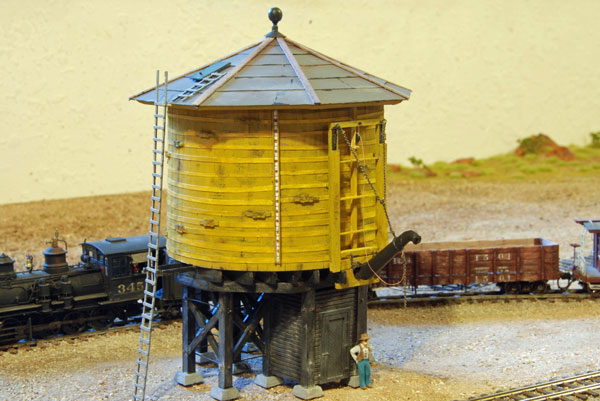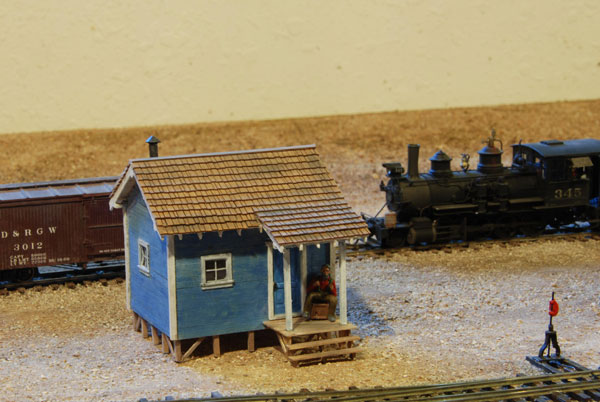HOn3 - White Pine D&RGW Narrow Gauge
Railroad
circa late 1940s
The fully-developed diorama
is on a 5'6" x 12'8" layout and can be viewed in a
3 minute video from Trackside Model Railroading.
It features over 30 buildings and structures (many of which were scratch build),
two track loops, including a fishing pond, a mountain and tunnel scene, and two
trestles.
It was featured in
Trackside Model Railroading
in their
November 2018
issue.
For
free current edition.
I've always been intrigued
with narrow gauge, even building a D&RGW sheep car from a wooden kit while
in high school (though I didn't have the HOn3 track to run it on). Knowing of the
wonderful detail and challenge of these kits, I ordered a Precision Scale
D&RGW Short Caboose (to try my hand with a plastic kit) and four Trout Creek Engineering
wooden-based kits, the D&RGW Flat Car, Box Car, Gondola, and Stock Car. In
all instances I used Blackstone
freight archbar or caboose trucks
(they run so smoothly, with brake pads added) and Kadee 714 couplers. The Trout Creek and Precision models offer great detail,
and I appreciated the addition of the under frame brake system. And it was wonderful to finally try
my hand at applying wet-based decals to these models. They certainly add a great level of
detail and realism.
To
initially exhibited these models, I built a 30" x 73" platform, and added some cork road bed, ballast,
placing here and there some Silflor Buffalo Grass, along with some "red rock
formations" and small shurbs, and finishing off the scenery with some Blue
Spruce from
Sterling Models.
I have an assortment of Weston Figures via
Campbell Scale Models. I used
Micro
Engineering code 55 Flex-Trak and two code 55 turnouts (from
Narrow Gauge Colorado)
with an operating Star
switch stands, powered by a Tortoise switch machine. The track is
powered with a
NCE Power Cab. I've constructed the diorama platform to be expandable
in either direction, by attaching add-ons.
I have
added the C-19 Class Consolidation
D&RGW #345 Blackstone.
This locomotive had such a colorful conclusion to its long history of service, from the 1880s to 1951, seen in the spectacular head-on collision in the 1952 film
Denver and Rio Grande. The C-19 version I have reflects its switcher days in the Durango yards
beginning in 1949.
I've begun constructing the structures, with a small scratch-built house, and a
DRGW water tank with its octagon roof
(from
Narrow Gauge Colorado).
I have several
Campbell Scale Models kits
awaiting the "construction team."
So
now begins the dreaming and planning to create a Durango switching yard diorama
of the late 1940s, or a free-lance spur with a number of
yard-related buildings and structures to complement the rolling stock and C-19.
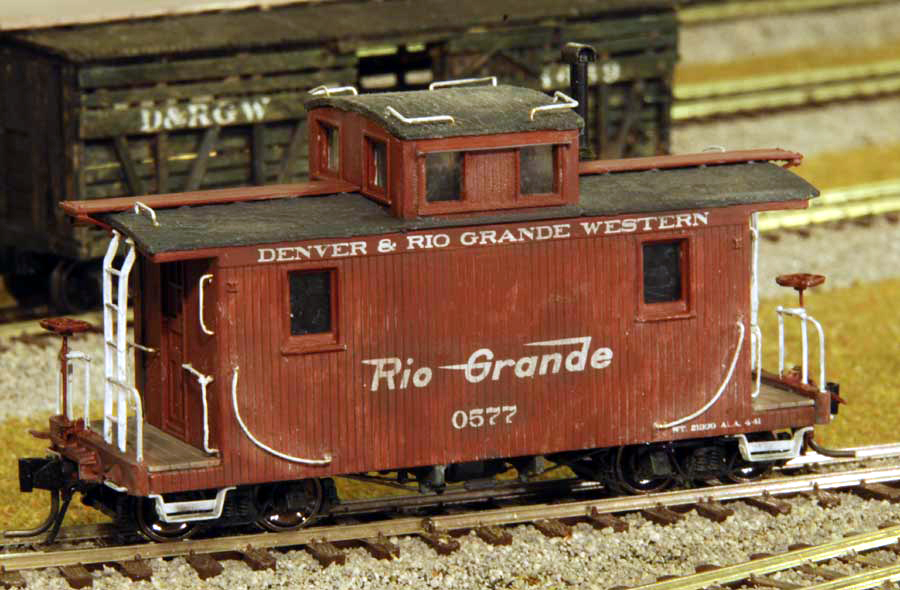 |
|
D&RGW Short Caboose, series #
0500 - # 0580. It is dry brush painted with a Polly Scale Oxide Red, with Reefer White used on the grab
irons and steps. I like working with the water-based paints (even on this plastic
surface) and use a dry brush application technique. The roof is the
Kleenex-tissue-on-Tarnish-Black-paint technique (with a little
fine-grained sanding after dry), to give the roof a
"canvas-like" texture. A little black soot and white ash Bragdon powders were added for weathering.
From a
Precision Scale plastic kit. My high-school built sheep car is in the background.
Built January 2010. |
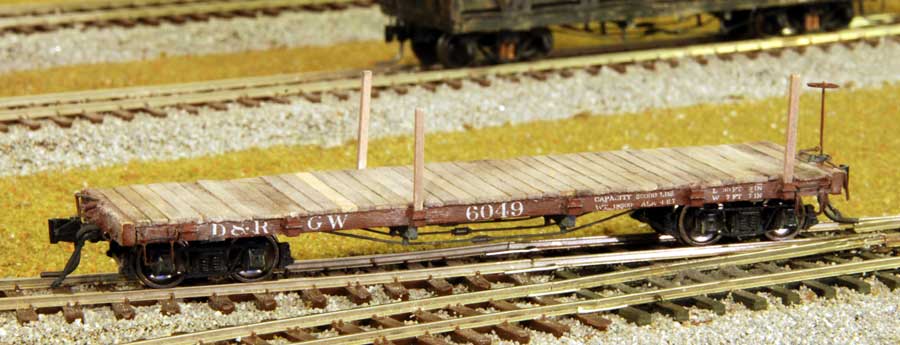 |
|
D&RGW Flat Car, series # 6000 -
# 6099. These 30' long flat cars were built in 1887. It is
dry brush painted with a Polly Scale Roof Red (darker than the Oxide Red), with a
coat of Tarnish Black on the under frame. A little soot and ash Bragdon
powders were added for weathering. From a Trout
Creek Engineering wood kit. Built February 2010.
|
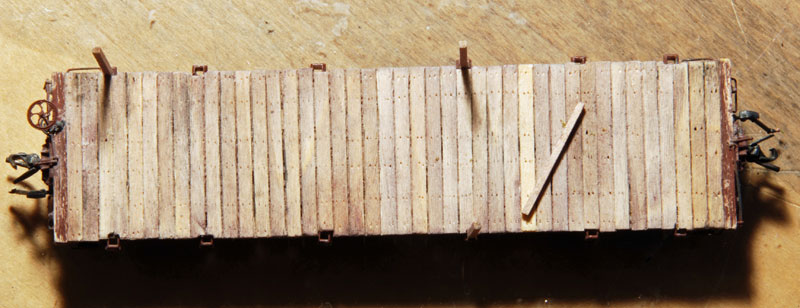 |
|
Top deck view of the D&RGW Flat
Car. Instead of using the one-piece, grooved floor planking, I separated
the individual boards, stressing each with a file and weathered
them. Then I attached each board to the under frame, adding needle
pricks to simulate the nail placements. Hopefully this adds
an appropriate aged look to this car.
|
 |
|
D&RGW Box Car, series # 3000 -
# 3749. They were originally built in 1903-04, and rebuilt
in 1924-26. This was
quite the project - I loved it! So many details. I really
like working with wood. Take your time with such projects. I
like frequent over-night pauses between each major construction stages,
during which I think through just how I'll engage the next construction
stage. It was dry brush painted with the Polly Scale Roof Red,
with a little Bragdon powder grimy gray applied along the sides and white ash
on the roof for weathering. And I've become more comfortable working
with the Rail Graphics wet decals. From a Trout Creek Engineering
wood kit. Built February 2010.
|
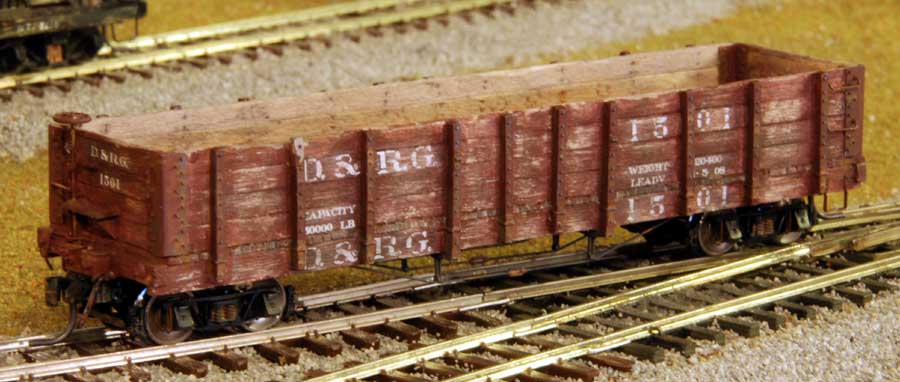 |
|
D&RG High Side Gondola, series #
1500 -
# 1899. They were originally built in 1903, and rebuilt
in 1920s. This model is of the original version. As an aging
gondola in use during the 1920s or 1930s, I sought to weather and stress
this car a little more so than the other rolling stock. As with the
box car, I loved this project, but it pays to take your time.
Think through the construction and options possible for each upcoming stage.
I
did fashion my own working coupler lift bars for this model, using small
eye bolts and fashioning the wire accordingly. To simulate a wood grain
texture on the side and end boards I scrapped the edge of a fine file
across each board. I
also placed needle pin points in the interior of the side boards to simulate
the bolt holes of the outer side stakes. With only a wash of water
and India ink on the interior of the car, the bolt holes came out nicely.
I stressed the tops of the side and end boards
with a file, adding a little depression between the side stakes to
simulate a history of some rough cargo loads being added and removed.
To
paint the external boards, I used a random combination of dry brushed Polly Scale Roof Red,
some at full strength and some diluted with water. All the external
hardware was given a coat of full strength Rood Red. Once the Rail Graphics wet
decals were added and a protective coat of Testors Dullcote Lacquer
added and thoroughly dried, I lightly sanded the lettering, some letters
more than others. A little Bragdon powder
black soot was then applied over the lettering, and along the side and
end boards. Over some parts of the metal pieces, such as corner
plates, coupler buffer blocks, side stake bolts, Kadee couplers,
grabirons, wheels, springs and frames of the Blackstone trucks, and some of the
"bolts" in the interior of the car, I brushed on very small
dabs of Floquil
Rust.
One last step. I realized I
had applied too much of the black soot powder. I first
attempted to remove some of it by "blowing" it off using a "cleaning
duster" (designed to remove debris from my computer keyboard), but with
only marginal results. So I then tried using small strips of
transparent tape, applying each firmly to a small section of the
surface. Upon pulling off the tape, excess powder was removed, as
was a little of the painted surface. But in so doing it also
helped re-expose the some of the itched grain of the wood. I think
it all resulted in a nice weathered finish, a technique that can be
further refined in my next project. I'm still learning.
When dealing with such tiny details and during the painting stages, it
helps to use a magnifying glass. Remember, all gets revealed
after photographing your model. From a Trout Creek Engineering
wood kit. Built February 2010.
|
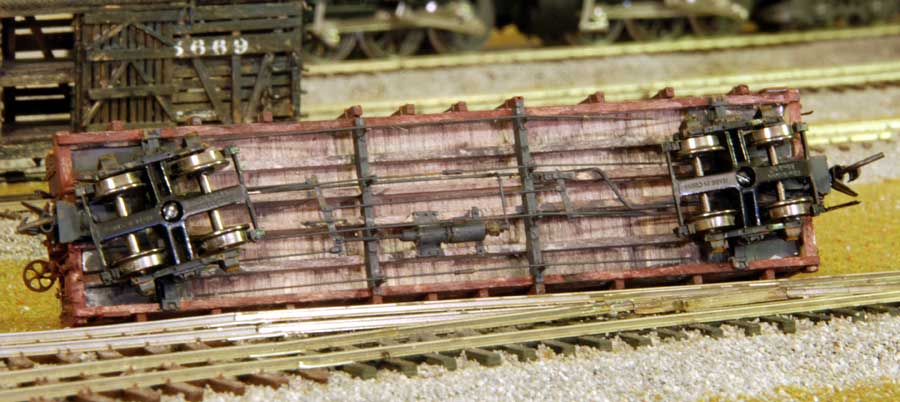 |
|
The underside of the D&RG Gondola, with the
detailed brake system. With the edge of a sharp file, I first
itched in the groves of the underside and sides of the floorboards, as only the
top view was provided in the kit stock. I covered the underside with a wash of
water and India Ink, while the brake system and truss rods were painted
with Polly Scale Tarnished Black. A little Floquil Rust as dabbed
here and there. As with the flat care, I've added small strips of
lead between the sills of the underbody over the trucks to add a little
more weight to this car.
|
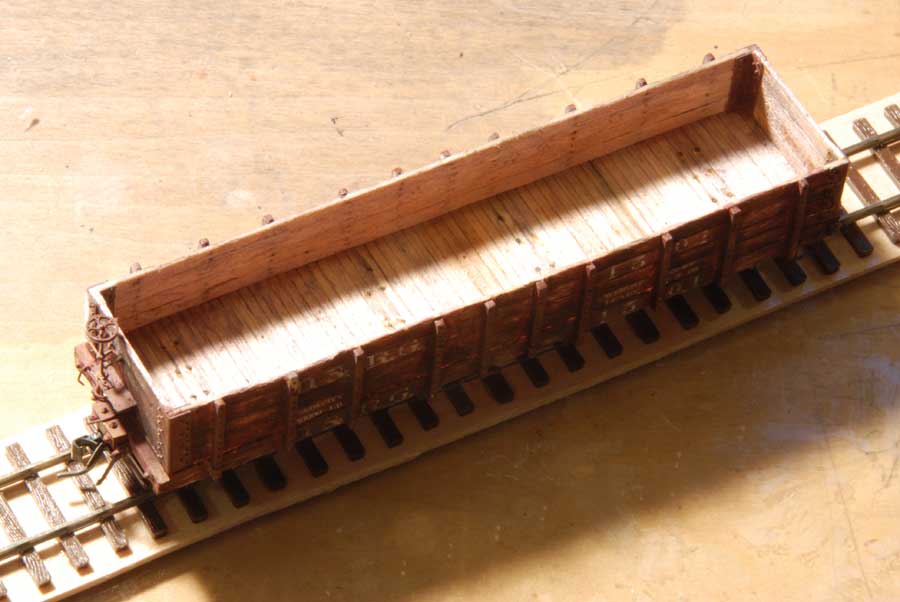 |
|
An above view of the D&RG
Gondola. To
simulate the bolts that are attached to the needlebeams
and bolsters through the floor boards, I marked the location, drilled
and inserted the ends of wire into the
flooring. I added a dot of Polly Scale Tarnished Black to each
wire head, as well as a small dab of Floquil Rust to some of the
"bolts" and surrounding boards.
|
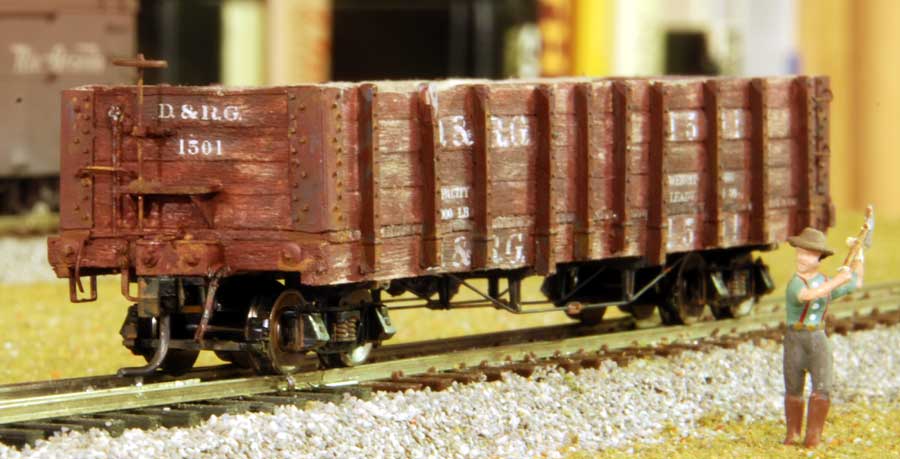 |
|
Close-up view of the end of the
D&RG
Gondola, with a worker along side, to add perspective.
|
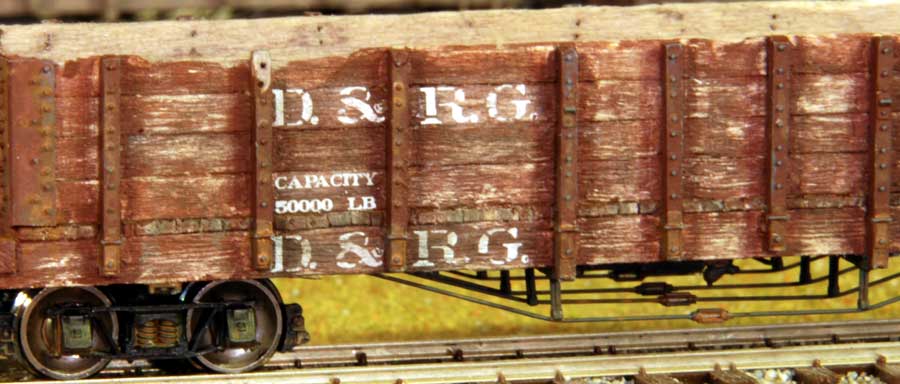 |
|
Close-up view of the wood grain
of the D&RG
Gondola.
|
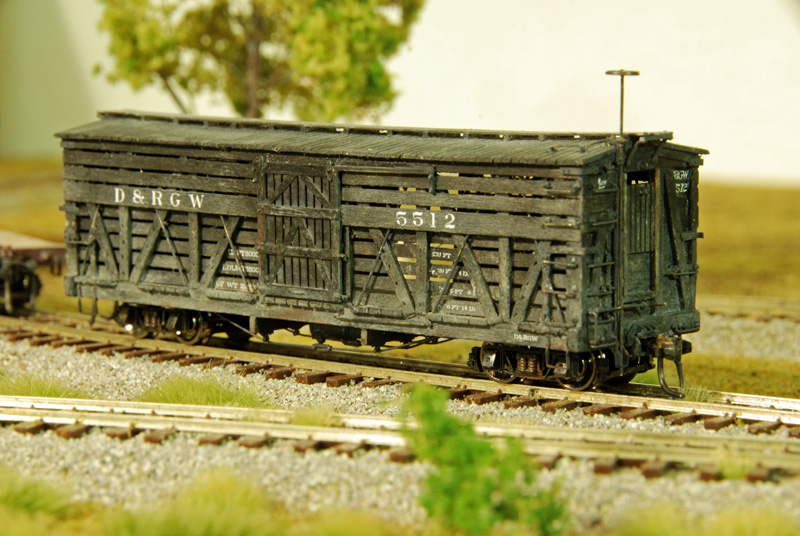 |
|
D&RGW Stock Car - 5500
Series - 30' From a Trout
Creek Engineering wood kit. The sway in the roof was
unintentional, but adds a nice touch. This one
was a lot more time consuming, given the
placement of all the individual boards; but so
rewarding. Used a Black Indian ink to
start the coloring. Used some Floquil Rust
paint on the couplers and trucks, and some of
the metal hardware. A
little gray soot and ash Bragdon powders were
added for weathering, particularly on the roof
and lower half of the car. While it took
some extra time, I put in individual bolts for
each of the grab iron mounts. Worked on, on and
off, over the winter into the summer of 2012. |
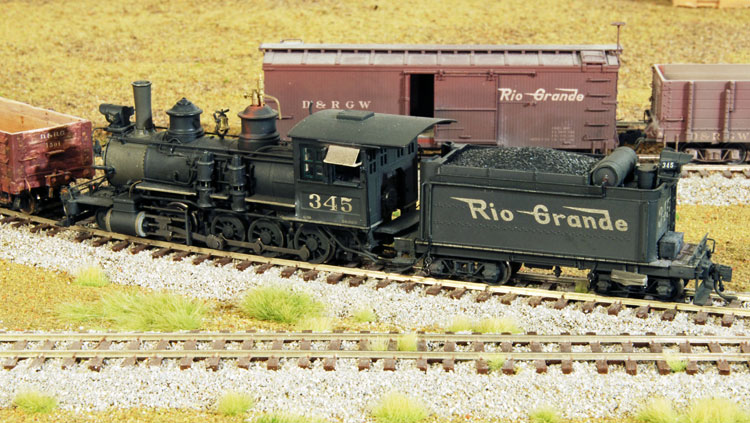 |
|
To add some wonderful motion and sound, I've
added the Blackstone Models C-19 #345, purchased
through
Narrow Gauge Colorado. The Blackstone
model is an absolutely wonderful piece of
functioning art. So visually detailed.
Even when it is parked, the variety of sounds
that emanate are so realistic. Added June 2014. |
return to
Rolling Stock











